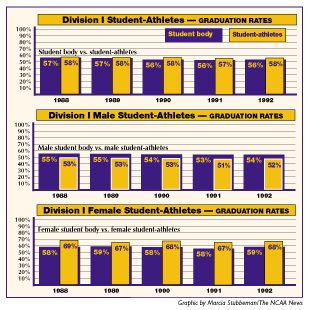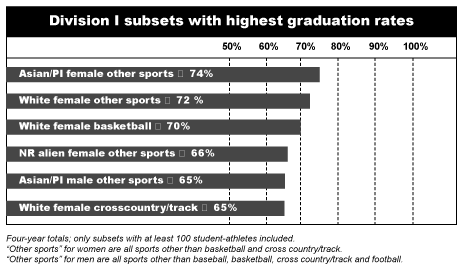The NCAA News - News and Features
The NCAA News -- August 30, 1999
Division I athletes continue to graduate at higher rate than overall student body
 The latest Division I graduation-rate report shows that Division I student-athletes graduate at a higher rate than the general student body, a trend that has held every year since Proposition 48 became effective with the 1986 freshman class. The latest Division I graduation-rate report shows that Division I student-athletes graduate at a higher rate than the general student body, a trend that has held every year since Proposition 48 became effective with the 1986 freshman class.
The most recent report examined the 1992 entering class of student-athletes. Of that class, which contained 66,938 student-athletes, 58 percent graduated within six years. The collective student body during the same period posted a 56 percent graduation rate.
Neither the student-athlete graduation rate nor that of the overall student body has changed meaningfully over the last six reports. Stu-dent-athletes have graduated at either a 57 or 58 percent rate in each of those years while the rate for the general student body has been either 56 or 57 percent. Compared to the 1991 class, the student-athlete rate was up 1 percent while the general rate was unchanged.
The report, compiled annually by the Association, was mailed to the membership and high schools across the nation in late August.
Female student-athletes continued to graduate at a much higher rate than males and than the overall female student body. In the 1992 entering class, 68 percent of all Division I female student-athletes graduated, just short of the all-time high of 69 percent that was recorded with the 1988 entering class. Division I male student-athletes graduated at a 52 percent rate, up 1 percent from the previous year but still 2 percent lower than the overall male student body.
In women's basketball, the graduation rate fell, dropping from 66 percent to 62 percent overall and from 55 percent to 49 percent for Blacks.
Division I male basketball players matched the 41 percent rate posted by the 1991 class. The rate for white male basketball players -- which fell to its lowest level in this history of the study when only 47 percent of the 1991 class graduated -- rebounded to 53 percent with the 1992 class. However, the rate for black male basketball players for the 1992 class slipped to 33 percent, a drop of four percent and the lowest figure since Prop 48 took effect.
While the figures are interesting and potentially meaningful, they are best viewed over the long term, said Todd A. Petr, NCAA director of research.
"You cannot overlook the fact that graduation rates for both student-athletes and the overall student body are essentially static," Petr said. "While an unusually high or low number in a particular area may trigger a need for closer observation, I think those who use this information need to understand that the figures -- especially racial subsets of particular sports -- are going to vary quite a bit from year to year. But if you look at the big picture, for the last six studies the overall rate for student-athletes has been either 57 or 58 percent."
The data are collected from all NCAA Division I colleges and universities. Only student-athletes who enroll as freshmen, receive athletically related financial aid and who graduate from that institution within six years of initial enrollment are tracked. Student-athletes who transfer in good academic standing and graduate elsewhere count against their original institution as not having graduated. They count in the freshman cohort rate for their second institution. Petr said the method is used because it is the only practical way to calculate rates that are comparable to the overall student body.
 The Division I report is distributed annually to 27,000 high schools for use by guidance counselors, coaches, students and parents. Higher education leaders, members of Congress and the media also receive the report. The Division I report is distributed annually to 27,000 high schools for use by guidance counselors, coaches, students and parents. Higher education leaders, members of Congress and the media also receive the report.
Similar information for Divisions II and III institutions was mailed at the same time as the Division I report.
Most of the information contained in the graduation-rate reports relates to individual institutions. Petr warned that these data should be reviewed in context and that those using the information should be aware when they are looking at extremely small subsets.
"It isn't uncommon to see that an institution has graduated none or all of its students in a particular subset in a particular year," Petr said. "But if there was only one athlete in that subset, the figure probably is not important."
|